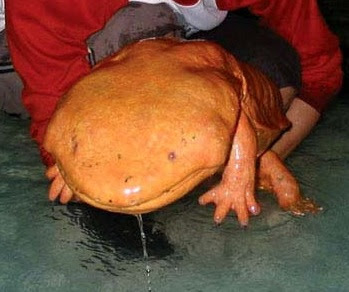
Posted on 08/23/2010 10:50:49 AM PDT by JoeProBono
It may be a shot in the dark, but freezing sperm is one of the last chances to save the hellbender, North America's biggest salamander, conservationists say.
Hellbenders—also known as snot otters and devil dogs—have dwindled throughout their range, which once encompassed streams from northeastern Arkansas to New York.
The 2.5-foot-long (0.7-meter-long) amphibians have declined by 80 to 90 percent in most of their traditional watersheds in recent decades, and healthy populations now haunt only isolated pockets of southern Appalachia (see map) and Pennsylvania, said Dale McGinnity, curator of reptiles at Nashville Zoo.
All of the states in the hellbender's range have protected the species, and the U.S. Fish and Wildlife Service is currently reviewing whether to give the hellbender federal protection, McGinnity said.
The reasons for their decline is unknown, but it's likely environmental contaminants such as pesticides are harming the creatures via their highly permeable skin, he said.
To make matters worse, hellbenders don't seem to be breeding much in the wild, he said, possibly because human-made pollutants containing synthetic hormones are damaging the amphibians' reproductive systems. Pollutants may also be harming the species' eggs or larvae.
As a result, there are apparently very few wild hellbenders in existence, leaving mostly aged individuals—the amphibians live at least 30 years and could live much longer.
(See photos of vanishing amphibians in National Geographic magazine.)
The hellbender's decline spurred an international team to collect sperm from some captive salamanders in September 2009 for cryopreservation, a common zoo practice that freezes sperm without damaging its cell membranes.
Though several zoos have put a "great deal of effort" into breeding the amphibians in captivity, none has been particularly successful, McGinnity added. It's unclear why they're tough to breed.
"For the first time, sperm was collected from a living salamander, cryopreserved, and brought back to life," said McGinnity, who is involved in the sperm-preservation effort with colleagues from Belgium's Antwerp Zoo and Michigan State University......

I see a similarity between the two subjects. Especially around the “smile.”

You forgot to ping Hellbender....8:)
[whom I shall now always fondly refer to as “Snot Otter”]
LOL

Hey baby, wanna hold my snot otter?
Joe.
I love your posts as you come up with some of the greatest photos I see on the Net.
Thank you.
By the way. These Snot Otters are REALLY UGLY!

a mud puppy by any other name.


That is a baby. How cute.
Those external lungs mimicking antlers are so neat.
My side hurts. You guys are killing me!
Hellbenders are the only species in the Genus Cryptobranchus and they only live in North America. There are two subspecies, the Ozark Hellbender (Missouri & Arkansas) which is very close to extinction, and the Eastern Hellbender which is doing a bit better.
Hellbenders are the 3rd largest salamander in the world, behind the Japanese and Chinese giant salamanders (the Chinese is the largest).
We grew up calling them Devil Dogs and used to find them in the creek on overcast autumn days.
I’ve kept another type of salamander, called an axolotl, for years. Axolotls often don’t go through metamorphosis, which allows them to remain aquatic and keep their gills. Axolotls which don’t undergo metamorphosis can be forced to do so by giving them various substances. When forced to mature fully, their lifespans are cut drastically.
They have been shown to be able to regenerate body parts, including parts of their brains, and can successfully accept transplanted body parts from other animals, including eyes and even parts of the brain.
They have unique hearts, too, and are used to study prenatal heart defects.
All of this makes them very important to medical researchers.
We should be concerned about the decline of amphibians in general, because their inability to breed has been linked to poor water quality. Poor water quality probably isn’t good for anything or anyone.
It would be a shame if animals like this hold the key to regenerating organs, aging, heart defects, or making transplants safer, only to see them go extinct before we can find out what their secrets are.

Out in the PNW we have mud puppies which are smaller but nonetheless impressive.
I LIKE you!
8:)
“They have been shown to be able to regenerate body parts, including parts of their brains,”
Things that make you go “Hmmmmm....” ping.
that photo you linked is from planetsave.com
they oppose all moutaintop removal coal mining.
they are very much what most folks here would call anti-conservative...they even have a category in which they lambast as comparable to Holocaust deniers people that many here respect and hold dear.
posting a pic from there is no different than linking from stormfront
Aarrgh. “Snot Otter”? I never heard that one before. However, thanks for alerting me to any threat to us slimy-skinned creeping folks. Us slippery amphibians got to stick together!
Disclaimer: Opinions posted on Free Republic are those of the individual posters and do not necessarily represent the opinion of Free Republic or its management. All materials posted herein are protected by copyright law and the exemption for fair use of copyrighted works.